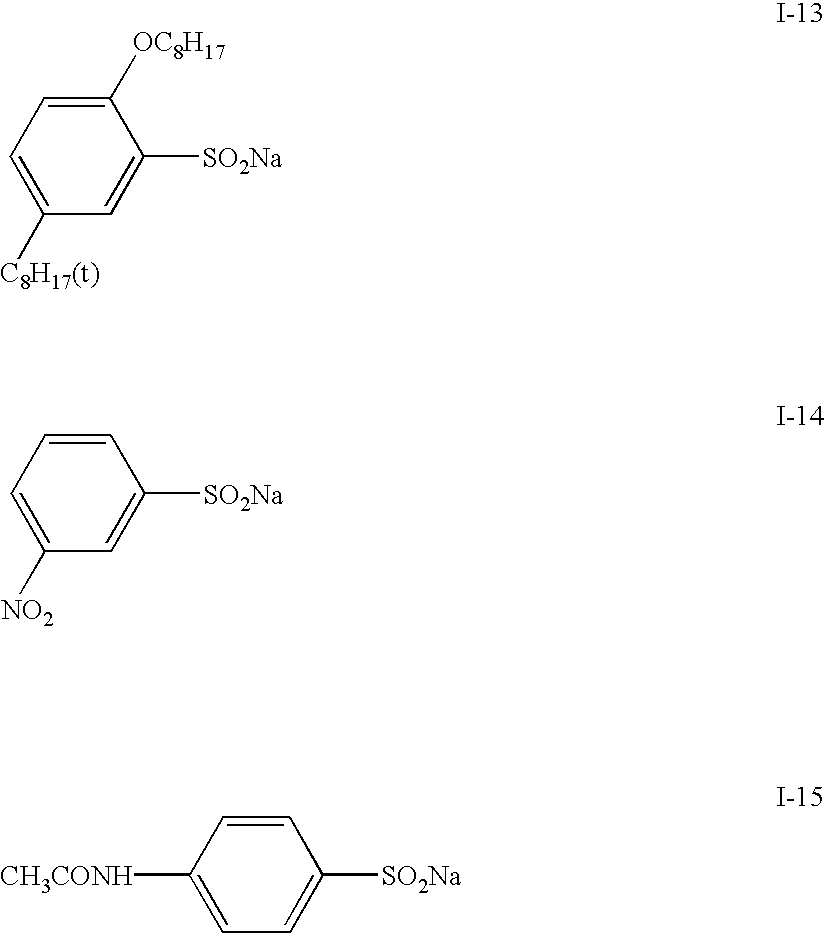Process for preparing a sulfinate
- Summary
- Abstract
- Description
- Claims
- Application Information
AI Technical Summary
Benefits of technology
Problems solved by technology
Method used
Image
Examples
example 2
> ##STR16##
Potassium hydrogensulfite (49.8 g, 0.414 mol) and potassium hydrogenphosphate (148 g, 0.850 mol) were added to 600 ml of water and then stirred. After dissolution of the salts, ethyl acetate (100 ml) and Compound II-12 (95 g, 0.207 mol) were added and then maintained at 35-40.degree. C. for 2 hours while stirring. When the reaction was completed, the reaction mixture was cooled to 10.degree. C., and the precipitated solid was collected by filtration. The obtained solid was washed with water and ethyl acetate to produce the target Compound I-12 (79.1 g), yielding 82.6%.
The structure of Compound I-12 was identified with mass spectrometry and NMR spectrometry. Its purity was determined employing high-performance liquid chromatography, yielding a purity of 99.0%.
example 3
> ##STR17##
Two molecular hydrous Compound I-1 (5.3 g) and Compound III-1 (10.0 g) were added to 50 ml of N, N-dimethylformamide and stirred at 95-100.degree. C. for 2 hours. After completion of the reaction, the reaction mixture was left to cool to room temperature. Then 100 ml of ethyl acetate and 100 ml of water were added. The reaction mixture was stirred and left undisturbed after which the separated aqueous layer was discarded. The obtained ethyl acetate layer was washed three times using an aqueous solution of sodium chloride. The aqueous layer was again discarded, and then the ethyl acetate solution was evaporated under reduced pressure. The residue was purified with column chromatography (carrier: silica gel; eluent: ethyl acetate / n-hexane=2 / 3 (in volume)) and was further recrystallized from acetonitrile. The amount of the target Compound IV-1 was 9.7 g at a yield of 84.4%.
The structure of Compound IV-1 was identified with mass spectrometry and NMR spectrometry, and revealed...
example 4
> ##STR18##
Compound I-3 (4.0 g) and Compound III-1 (4.3 g) were added to 50 ml of N, N-dimethylformamide and stirred at 90-95.degree. C. for 2 hours. After completion of the reaction, the reaction mixture was left to cool to room temperature. Then, 100 ml of ethyl acetate and 100 ml of water were added. The reaction mixture was stirred and left undisturbed. The resulting separated aqueous layer was discarded. The obtained ethyl acetate layer was washed three times with an aqueous solution of sodium chloride. The aqueous layer was again discarded, and then the ethyl acetate solution was evaporated under reduced pressure. The residue was purified with column chromatography (carrier: silica gel; eluent: ethyl acetate / n-hexane=1 / 2 (in volume)) and was further recrystallized from acetonitrile. The amount of the target Compound IV-2 was 6.0 g, at a yield of 87.4%.
The structure of Compound IV-1 was identified with mass spectrometry and NMR spectrometry and revealed a melting point of 144-1...
PUM
| Property | Measurement | Unit |
|---|---|---|
| Reduction potential | aaaaa | aaaaa |
Abstract
Description
Claims
Application Information
 Login to View More
Login to View More - R&D
- Intellectual Property
- Life Sciences
- Materials
- Tech Scout
- Unparalleled Data Quality
- Higher Quality Content
- 60% Fewer Hallucinations
Browse by: Latest US Patents, China's latest patents, Technical Efficacy Thesaurus, Application Domain, Technology Topic, Popular Technical Reports.
© 2025 PatSnap. All rights reserved.Legal|Privacy policy|Modern Slavery Act Transparency Statement|Sitemap|About US| Contact US: help@patsnap.com



